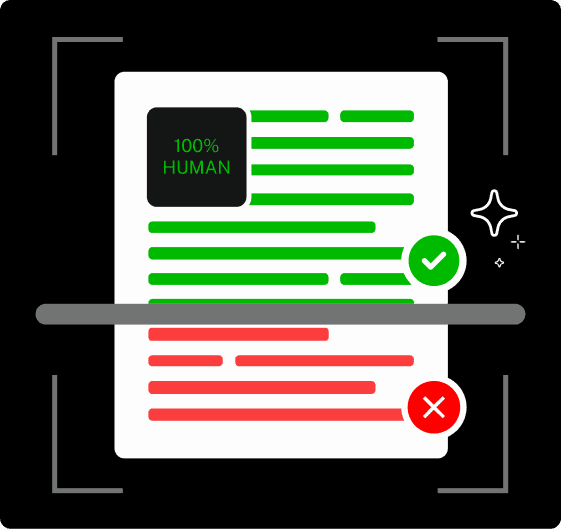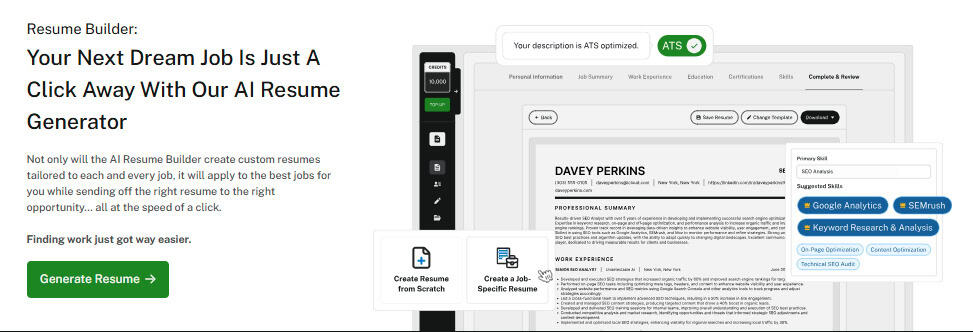Your resume should speak more than just about your history of employment. It is a means to tell your story as well as your job history.
The greatest thing is to ensure that your recruiter pays attention to you and considers you the best fit for the position.
Most resumes that succinctly present the experience of the candidate usually speak to recruiters and drive the most results.
Therefore, bullet points are one of the most underrated elements in many resumes.
You can organise your job roles into concise points of your responsibilities and achievements across different industries with bullet points.
This helps recruiters quickly scan and assess your fit for a role. So, how many bullet points per job on a resume is ideal?
Let’s dive in.
Ideal Number of Bullet Points Per Job

When creating your resume, you might also be asking yourself, “On a resume how many bullet points per job is the right choice?”
The fact is, there is not a single straightforward answer on resumes.
The format and information presented on your resume needs to be tailored to meet the job requirements.


Never Worry About AI Detecting Your Texts Again. Undetectable AI Can Help You:
- Make your AI assisted writing appear human-like.
- Bypass all major AI detection tools with just one click.
- Use AI safely and confidently in school and work.
Even so, HR specialists and hiring managers usually recommend 3-6 bullet points for a job entry.
Using this guideline, you may present your achievements comprehensively yet concisely and making it easy to read.
However, the number of bullet points that you insert in a job depends on the previous work experience and accomplishments.
Follow the rule of thumb below on the ideal number of bullet points for varying years of experience at a job.
- 1-2 Years: 3 bullet points
- 3-5 Years: 4-5 bullet points
- 5+ Years: Up to 6 bullet points
This format is ideal and realistic because you will have likely made more achievements with 5+ years of experience in a role than someone with 3 or 4 years in the same role.
For example, let’s look at how different candidates break down their experience for a job role below.
Which one looks more realistic?
Example 1
SOCIAL MEDIA MANAGER, Jan 2021 – Dec 2022
Guide marketing agency
- Spearheaded a comprehensive digital marketing strategy that doubled company-wide sales revenue by 100% through data analytics frameworks and behavior surveys across multi-platform campaigns.
- Conceptualized and developed a groundbreaking series of interactive weekly media experiences, including Instagram Live symposiums and Twitter Space think tanks, resulting in a 400% uplift in customer engagement metrics and stakeholder perception.
- Engineered high-conversion ad funnels by deploying psychographic segmentation and real-time A/B testing, optimizing cost-per-click by 72% and reducing customer acquisition cost by 58%.
Example 2
SOCIAL MEDIA MANAGER, Jan 2021 – Dec 2022
Guide marketing agency
- Increased sales performance by 100% through strategic social media engagement and ad campaigns.
- Grew audience from 300 to 3,000+ organic followers within a year.
- Hosted weekly Instagram Live sessions and Twitter Spaces to boost brand engagement.
- Developed cost-effective paid ad strategies tailored to niche audiences.
From the two examples, it is clear which is false and which is more realistic. In the first example, the candidate used many bogus words and unrealistic metrics for a short-term role.
Meanwhile, the second candidate uses clear, actionable metrics and language when stating their job achievements for the same role. It is clear who made the right choice.
Having less experience in a role with a number above six bullet points may be overwhelming unless the role is highly complex or multifaceted.
Quality Over Quantity
When making your resume, your question shouldn’t be “how many bullet points should you have per job on a resume.” You also need to consider how impactful those points you have included are.
In your resume, your goal should be to showcase quality over quantity.
By quality, you prioritize roles that are more tailored to the position than just info dumping.
Avoid descriptions like these:
- Managed two social media accounts
- Addressed customer complaints
- Responsible for email correspondence
- Organized events and promotional activities
Rather, let your job experience reflect your achievement like this:
- Prepared content strategy for Instagram, leading to a 60% increase in engagement.
- Resolved over 200 customer complaints monthly with a 98% satisfaction rate.
- Organized promotional events and outreach programs, which increased sales by 50% within 3 months
Each bullet point must demonstrate a specific action, followed by a measurable result and the overall value you contributed to that position.
One pro tip is to rely on strong action verbs like “optimized”,” implemented”, “streamlined.” etc.
However, if you need help putting together a good resume, our undetectable AI-powered Resume Builder makes it a breeze.
If you still do not know how many bullet points per job on a resume will work for you, you are in the right place.
This tool suggests action verbs and scans your resume for any redundancy. It also helps you highlight the greatest achievements in your career.

Tailoring Bullet Points for Each Job Application
Generic resumes usually cannot communicate the details needed for specific job vacancies. It is important that you adapt your job application to the precise qualifications of the job you wish to pursue.
Casting a long list of all lifetime achievements on your resume is not enough.
Make sure your resume represents those skills and abilities that match what you are applying for in terms of a job.
Here are our pro tips on how to structure your bullet points more effectively for specific roles:
- Point out only the most recent relevant experience. This includes experiences within the last one or two years, showcasing your skills and currency in that field.
- A smart move to make is parroting the language that is used in the job posting. Such an approach helps you ensure you have understood everything required of the job and that you are a good fit for it. This way, recruiters can have a better understanding of the abilities you have to offer to the role.
- If you are switching to a new industry, show how your existing skills could be transferred to your new job.
For instance, your job description should highlight your leadership roles if you’re moving from project management to admin roles.
It will be best to emphasize that you have organized your team in previous roles and how this improved your workflow and helped you achieve results.
Tailor your bullet points to speak to your decision-making qualities and other relevant skills that interest your recruiter.
Additionally, using the undetectable Smart Applier tool, you can easily auto-match your resume bullet points to each job application.
It filters and prioritizes only relevant content, helping you craft and submit personalized applications faster.

Bullet Point Formatting Tips
The idea behind bullet points is to present your experience and qualifications in a concise and explanatory format.
This clean formatting helps your resume pass both ATS systems and human reviews. So, how many bullet points should you have on a resume?
Follow these formatting tips to learn more:
- Use Standard Bullet Symbols: Use circles or dashes. This standard format is used in many locations, allowing your resume to pass through different screenings and test systems.
- Start Each Point With a Verb: Use action words like maintained, managed, completed, etc. This helps with clarity and also showcases your responsibilities more effectively.
- Maintain Consistent Tense: Use past tense when discussing past roles and present tense when describing current roles.
- Use Numerals for Numbers: Another formatting tip is to always use numeric figures instead of words. For instance, use “50%” instead of “fifty-percent.”
- Use the Same Font Throughout: Make sure you use a uniform font size and format throughout your resume. This is a way to show your organization’s attention to detail. Remember where you must put words in bold and ensure the dates are accurate.
Some formatting techniques to avoid include the following:
- Leaving too many space gaps between job roles
- Using lengthy sentences and paragraphs
- Starting each sentence with a first-person pronoun, e.g, “I”, “We”
Common Mistakes to Avoid
No one is above mistakes, but the standard is always closest to perfection when it comes to resumes. Some errors can be fatal and can cause even the most qualified candidate to lose the application.
Here are some common mistakes to avoid if you’re learning how many bullet points per job on a resume.
- Too Many Bullet Points: Many people make the mistake of overloading resumes with too much information and losing the recruiter’s attention. Having more than 6 – 10 bullet points for every job clutters your resume. Remember that on a resume, how many bullet points per job you include should be based on significance and not memory. If you have extra details that you would like to expand on, you can address this in your cover letter.
- Lack of Value: No one should limit themselves to merely listing out daily tasks or basic job duties. Instead, you should discuss your contributions and achievements. One method that has been proven is to use specific metrics in your description.
Instead of saying “Helped to improve sales,” say “Increased monthly sales by 50% within 1 year.” These metrics help to highlight the significance of your achievements and speak to your growth.
- Irrelevant Tasks: Your resume should focus on your achievements and contributions. It should reflect your strengths and excellence in that role. Including irrelevant tasks will only muddle up your resume and take away from the main goal.
- Inconsistent Tone: When building your resume, you should maintain a professional, active voice throughout. Don’t use an informal tone in some places; use a formal tone under another heading. We also recommend using the same font throughout. Also, you can use capitalization and bold formatting to make your headings and keywords stand out.
FAQs: Resume Bullet Points
Can I Use More Than 6 Bullet Points For a Job?
Generally, having more than 6 bullet points per job is not recommended, especially for entry-level and junior executive roles.
Most experts recommend that 3-4 bullet points per job will do the trick.
However, this is not a fixed rule because there are instances where you can have 6 bullet points per job.
This is especially the case for complex roles with distinct responsibilities. Otherwise, stick to 3–5.
Should I Include Bullet Points for Older Jobs?
Yes, you can include older job positions in your resume especially if you’re moving to a more senior role. This is a good way to boost your candidacy.
However, you’re not under any obligation to include all the jobs you have ever had in your resume.
Therefore, if the bullet points are relevant to the position you’re applying for, yes. Otherwise, just list the job title and dates.
How Many Bullet Points Are Too Many?
There is no hard and fast rule on what number is too many. Some recommend sticking to 3-5 bullet points per role.
In comparison, some recommend having up to 8 bullet points for a high-level position demanding lots of experience.
However, anything that makes your resume look cluttered will count as too many. Your aim should always be to ensure clarity and focus.
Final Thoughts
So, how many bullet points per job on a resume is ideal? The answer is subjective because different job applications come with their demands.
We encourage you to stick to 3-5 high-value bullet points per job, depending on the role’s relevance. You should also remember to tailor each application to the specific role to increase your chances.
Ultimately, you don’t have to labour for days over your CV.
You can customize each application effectively with the Undetectable AI Resume Builder and Smart Applier.
Meanwhile, you can make your content ATS-friendly and conversational with our Humanizer and Paraphraser tools.
With these tools, next time someone asks you, “How many bullet points should you have per job on resume?”, you’ll have the answer and the tools to back it up.
